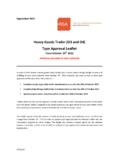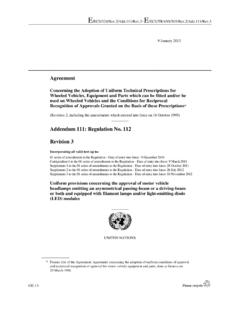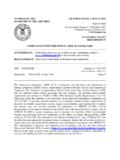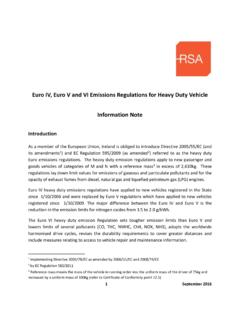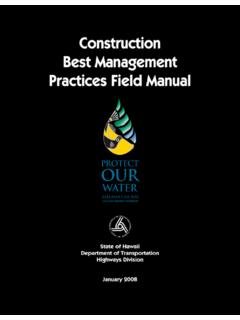Transcription of U.S. DEPARTMENT OF TRANSPORTATION - …
1 TP-302-03 Oct 18, 1991 DEPARTMENT OF TRANSPORTATION NATIONAL HIGHWAY TRAFFIC SAFETY ADMINISTRATION LABORATORY TEST PROCEDURE FOR FMVSS 302 Flammability of Interior Materials SAFETY ASSURANCE Office of vehicle Safety Compliance Mail Code: NSA-32 400 Seventh Street, SW Washington, DC 20590 OVSC LABORATORY TEST PROCEDURE NO. 302 TABLE OF CONTENTS PAGE 1. PURPOSE AND 1 2. GENERAL 2 3. SECURITY .. 3 4. GOOD 3 5. TEST SCHEDULING AND MONITORING .. 3 6. TEST DATA 3 7.
2 GOVERNMENT FURNISHED PROPERTY (GFP).. 4 8. CALIBRATION OF TEST 5 9. PHOTOGRAPHIC DOCUMENTATION .. 6 10. 7 11. PRETEST 8 12. COMPLIANCE TEST 10 13. POST TEST 16 14. REPORTS .. 17 MONTHLY STATUS 17 APPARENT TEST FAILURE .. 17 FINAL TEST REPORTS .. 17 17 18 FIRST THREE 18 TABLE OF CONTENTS.
3 24 15. DATA 25 16. FORMS .. 28 1 1. PURPOSE AND APPLICATION The Office of vehicle Safety Compliance (OVSC) provides contracted laboratories with Laboratory Test Procedures (TPs) which serve as guidelines for obtaining compliance test data. The data are used to determine if a specific vehicle or item of motor vehicle equipment meets certain minimum requirements of the subject Federal Motor vehicle Safety Standard (FMVSS). The purpose of the OVSC Laboratory Test Procedures is to present a uniform testing and data recording format, and provide suggestions for the use of specific equipment and procedures.
4 Any contractor interpreting any part of an OVSC Laboratory Test Procedure to be in conflict with a Federal Motor vehicle Safety Standard or observing any deficiencies in a Laboratory Test Procedure is required to advise the Contracting Officer's Technical Representative (COTR) and resolve the discrepancy prior to the start of compliance testing. Contractors are required to submit a detailed test procedure to the COTR before initiating the compliance test program. The procedure must include a step-by-step description of the methodology to be used. The OVSC Laboratory Test Procedures are not intended to limit or restrain a contractor from developing or utilizing any testing techniques or equipment which will assist in procuring the required compliance test data.
5 NOTE: The OVSC Laboratory Test Procedures, prepared for use by independent laboratories under contract to conduct compliance tests for the OVSC, are not intended to limit the requirements of the applicable FMVSS(s). In some cases, the OVSC Laboratory Test Procedures do not include all of the various FMVSS minimum requirements . Sometimes, recognizing applicable test tolerances, the Test Procedures specify test conditions which are less severe than the minimum requirements of the standards themselves. Therefore, compliance of a vehicle or item of motor vehicle equipment is not necessarily guaranteed if the manufacturer limits its certification tests to those described in the OVSC Laboratory Test Procedures.
6 2 2. GENERAL requirements Federal Motor vehicle Safety Standard (FMVSS) No. 302, "Flammability of Interior Materials," specifies burn resistance requirements for materials used in the occupant compartments of motor vehicles. The purpose of this standard is to reduce the deaths and injuries to motor vehicle occupants caused by vehicle fires, especially those originating in the interior of the vehicle from sources such as matches or cigarettes. The standard applies to passenger cars, multipurpose passenger vehicles (MPVs), trucks, and buses.
7 The following components of vehicle occupant compartments shall meet the requirements of the standard. Any portion of a single or composite material which is within inches of the occupant compartment air space shall meet the requirements of the standard. Seat cushions Seat backs Seat belts Headlining Convertible tops Arm rests Trim panels Compartment shelves Head restraints Floor coverings
8 Sun visors Curtains Shades Wheel housing covers Engine compartment covers Mattress covers Instrument panel padding Other material designed to absorb crash energy Material shall not burn, nor transmit a flame front across its surface, at a rate of more than 4 inches per minute.
9 However, the requirement concerning transmission of a flame front shall not apply to a surface created by the cutting of a test specimen for purposes of testing. If a material stops burning before it has burned for 1 minute from the start of timing, and has not burned more than 2 inches from the point where timing was started, it shall be considered to meet the burn-rate requirement of the standard. 3 3. SECURITY The contractor shall provide appropriate security measures to protect the OVSC test specimens from unauthorized personnel during the entire compliance testing program.
10 The contractor is financially responsible for any acts of theft which occur during the storage of test specimens. Any security problems which arise shall be reported by telephone to the Industrial Property Manager (IPM), Office of Contracts and Procurement, within two working days after the incident. A letter containing specific details of the security problem will be sent to the IPM (with copy to the COTR) within 48 hours. The contractor shall protect and segregate the data that evolves from compliance testing before and after each test. No information concerning the safety compliance testing program shall be released to anyone except the COTR, unless specifically authorized by the COTR or the COTR's Branch Chief or Division Chief.
